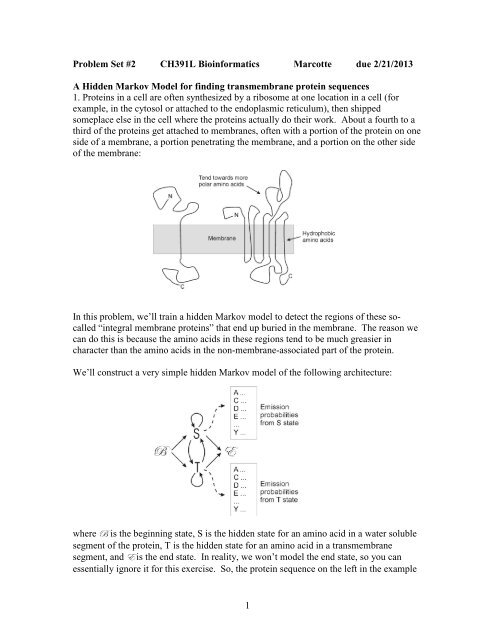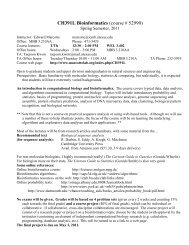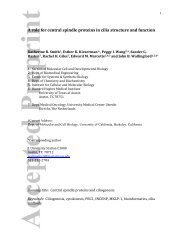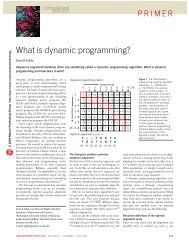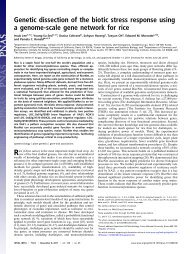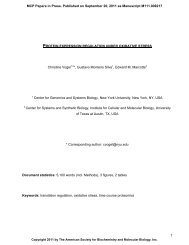1 Problem Set #2 CH391L Bioinformatics Marcotte ... - Marcotte Lab
1 Problem Set #2 CH391L Bioinformatics Marcotte ... - Marcotte Lab
1 Problem Set #2 CH391L Bioinformatics Marcotte ... - Marcotte Lab
Create successful ePaper yourself
Turn your PDF publications into a flip-book with our unique Google optimized e-Paper software.
<strong>Problem</strong> <strong>Set</strong> <strong>#2</strong> <strong>CH391L</strong> <strong>Bioinformatics</strong> <strong>Marcotte</strong> due 2/21/2013A Hidden Markov Model for finding transmembrane protein sequences1. Proteins in a cell are often synthesized by a ribosome at one location in a cell (forexample, in the cytosol or attached to the endoplasmic reticulum), then shippedsomeplace else in the cell where the proteins actually do their work. About a fourth to athird of the proteins get attached to membranes, often with a portion of the protein on oneside of a membrane, a portion penetrating the membrane, and a portion on the other sideof the membrane:In this problem, we’ll train a hidden Markov model to detect the regions of these socalled“integral membrane proteins” that end up buried in the membrane. The reason wecan do this is because the amino acids in these regions tend to be much greasier incharacter than the amino acids in the non-membrane-associated part of the protein.We’ll construct a very simple hidden Markov model of the following architecture:where U is the beginning state, S is the hidden state for an amino acid in a water solublesegment of the protein, T is the hidden state for an amino acid in a transmembranesegment, and X is the end state. In reality, we won’t model the end state, so you canessentially ignore it for this exercise. So, the protein sequence on the left in the example1
above would be something like SSSSSSSSSSSSSSSTTTTTTTSSSSSSSSSSSS and theprotein sequence on the right would have seven runs of T’s, flanked and interspersed withruns of S’s.From the course web page, download 3 data sets:soluble_sequences, transmembrane_sequences, and state_sequencesThese files have, respectively, a set of amino acid sequences from soluble segments ofproteins, a set of amino acid sequences from trans-membrane regions of proteins, and aset of state sequences for all of the known integral membrane proteins of yeast.Calculate the frequencies of amino acids in the first two files (remember your programsfrom the first problem set?). Use these frequencies to generate the emission probabilitytables of the S and T states of the HMM.Calculate the frequencies of beginning a sequence in each of the 2 states in the third file.Use these to calculate the transition probabilities from the beginning state of the HMM.Calculate the number of occurrences of each digram in the state file. (e.g., SS or TT orST or TS. A digram is a 2 character string. In general, a string of n characters is an n-gram.) You can use your other program from problem set#1 for this. From the numbersof observations, you should be able to construct the transition probability matrix for theHMM.Now, take the amino acid sequence KKIIFFFFL and calculate the most likely statesequence using the Viterbi algorithm.Turn in the transition probability matrix, emission probability matrix, the Viterbi matrix,and the most likely state sequence.2. What are the relative proportions of transmembrane and non-transmembrane aminoacid segments (i.e, segments of all T or all S) in integral membrane proteins?3. Draw a reasonable alternate architecture for the transmembrane sequence predictingHMM. Why might you prefer one of the two HMM architectures over the other?4. Draw a reasonable architecture for an HMM that would identify secondary structuresin proteins. If you wanted to take into account the fact that some particular mixtures ofsecondary structures were more common than others (for example, there are manyproteins which have only beta sheets, many which have only alpha helices, many whichare mixed alpha/beta, and some which aren’t so easily categorized), how would youmodify your model to incorporate this data? Draw the modified model as well.5. Suggest an application (ANY application!) of HMM’s to a biological problem otherthan the applications we have discussed (e.g., gene finding, CpG islands, proteinsecondary structure or transmembrane segment prediction, sequence alignment). Suggesta reasonable HMM architecture that could be applied to the problem.2


